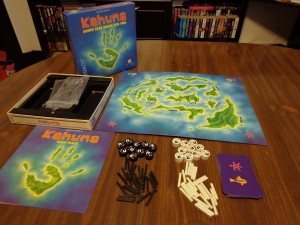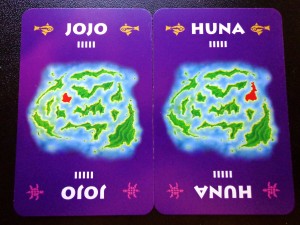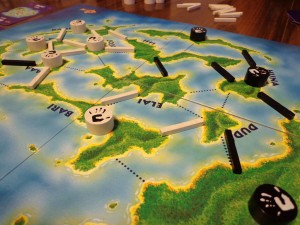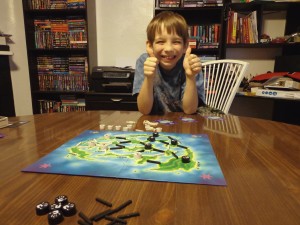Two powerful beings. A bunch of islands. Powerful magic. How will they settle their differences? Why…by building bridges, of course! It certainly makes more sense than the last season of Lost…so why not?
In Kahuna, each player will be assuming the role of a powerful priest. These priests will be jockeying for position and attempting to control more islands than their opponent. A priest can assume control of an island if they control the majority of the bridges that lead to it. The more islands a player controls the better, and the player who gains the most victory points over a series of three rounds wins the game. Let’s take a quick look at the components and gameplay before heading into the review.
Components
Stones – These Kahuna stones are used for marking territory. Each player receives ten.
Bridges – Bridges are built between islands and determines who has superiority over an area. Each player receives twenty-five of them.
Cards – Each card has the name of an island on the board. They are played during the game so that bridges can be built (or removed) between islands. There are twenty-four cards, two for each island.
Setup & Gameplay
The deck of cards is shuffled and three are laid face up next to the draw deck. Each player picks a color, gets their pieces, and draws three cards from the face down draw deck. The starting player is the non-dealer, though feel free to pick one at random.
On a player’s turn, they may:
1. Play Cards
A player can play as many cards as they want from their hand. Playing a single card allows them to construct a bridge on any of the unoccupied dotted lines leading from it. Playing two cards of the same name or two cards of bordering islands allows that player to remove an enemy bridge. Cards that have been played are placed in a discard pile.
If that player has the majority of bridges on an island (3 out of 5 possible bridges for example) then they place a stone on that island. Any enemy bridges leading from that island are removed.
2. Draw a Card
The player can draw a card from the face down draw deck, or from one of the face up cards.
Scoring and Endgame
The game is played over three rounds. The end of a round is noted when there are no more cards to draw from either the face down draw deck or the three cards nearby. Scoring occurs at the end of every round as follows:
Round One: Whoever has the most Kahuna stones on the board gets one point. Shuffle the discard pile and start a new draw pile.
Round Two: Whoever has the most Kahuna stones on the board gets two points. Shuffle the discard pile and start a new draw pile.
Round Three: Whoever has the most Kahuna stones on the board scores the difference. For example, if White had five and Black had three, White scores two points.
Whoever has the most points at the end of the third round wins!
Above is simply an overview of the game. For detailed information, please check out the manual here:
The Review
The game turned out to be pretty fun…it was a challenge to keep what I had under my control. The game has a mix of both strategy and luck, so sometimes no matter how well I seemed to play, luck would hold me back. The game does help to offset the luck of the draw by giving the player three face up cards to choose from, which in my opinion is a bonus.
The box and the components are fairly light, making it ideal for travel when going on vacation. You couldn’t play it in the car, but it certainly is small enough to where you wouldn’t need a lot of room to play. The cards and the text are easy to read and the pieces are sturdy, so no complaints in that department.
Vinnie (11) and I played a quick game, but it was close in score all the way through. In the first round, we had our pick of bridges to place, gaining territories with ease. We expanded our hold on islands without running into each other much, if at all. We ended up tying the first round and thus no one scored any points. The second round was a different story…the board was beginning to feel cluttered and we were constantly stepping over each other, claiming territories, and removing bridges as the result of claiming said territories. He pulled ahead by one territory, bringing the score to 0-2. The last round was very cluttered and I had to change tactics a bit. I concentrated on removing his bridges and I was able to remove enough to where he lost the majority on a few islands, but it wasn’t enough. My six to his five islands gave me one point…not enough to tie him or win the game.
We both felt that the game was well balanced…that is…neither of us felt like the other was running away with the lead. Next time, I intend to try mixing up my tactics and try to remove his bridges earlier than the third round. All in all, I thought it was decent two player game…it is certainly casual enough that it would appeal to families looking for some one on one time with a spouse or sibling.
Final Verdict: 6/10




